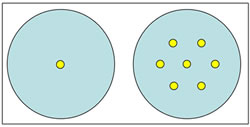
Japanese Researchers Break World Record In Optical Fiber Transmission Capacity
Japanese researchers have successfully demonstrated an optical data rate of 109 Terabit per second (Tb/s) within a single optical fiber, breaking the 100 Tb/s limit, which was believed to be the physical limit of a single optical fiber.
Researchers from Japan's National Institute of Information and Communications Technology (NICT) and Sumitomo Electric Industries, Ltd. (SEI) said that the new technology as well as other optical transmission techniques could increase the optical transmission capacity of current optical fibers by 1000 times.
An optical fiber is a fiber that acts as a wave-guide, or "light pipe", to transmit light between the two ends of the fiber. Optical fibers are widely used in fiber-optic communications, which permits transmission over longer distances and at higher bandwidths (data rates) than other forms of communication.
The diameter of the current optical path of light within an optical fiber (core) is just 9 microns and its energy density is comparable to the density met on the sun's surface. However, the quality of the optical signal is affected by factors such as damages on the fiber itself caused by the high power and temperatures.
By 2001, researchers believed that an optical fiber could allow for a transmission of up to 100 Tb/s.
 Many transmission techniques have been developed in an effort to increase the data rates within optical fibers. These include the use of multiple optical paths or cores within a single fiber, although the leaked signals interfered with each other causing noise.
Many transmission techniques have been developed in an effort to increase the data rates within optical fibers. These include the use of multiple optical paths or cores within a single fiber, although the leaked signals interfered with each other causing noise.
NICT researchers have managed to solve the multicore problem and achieved a quality transmission at 109Tb/s for a distance of 16.8km. They used was a special and ultra-fast optical signal modulator (QPSK modulator), that managed to simultaneously transmit information carried on seven optical cores.
The researchers believe that the new technology could boost the capacity of optical fibers by x1000, while maintaining high-quality and secure signal transmissions.
An optical fiber is a fiber that acts as a wave-guide, or "light pipe", to transmit light between the two ends of the fiber. Optical fibers are widely used in fiber-optic communications, which permits transmission over longer distances and at higher bandwidths (data rates) than other forms of communication.
The diameter of the current optical path of light within an optical fiber (core) is just 9 microns and its energy density is comparable to the density met on the sun's surface. However, the quality of the optical signal is affected by factors such as damages on the fiber itself caused by the high power and temperatures.
By 2001, researchers believed that an optical fiber could allow for a transmission of up to 100 Tb/s.
 Many transmission techniques have been developed in an effort to increase the data rates within optical fibers. These include the use of multiple optical paths or cores within a single fiber, although the leaked signals interfered with each other causing noise.
Many transmission techniques have been developed in an effort to increase the data rates within optical fibers. These include the use of multiple optical paths or cores within a single fiber, although the leaked signals interfered with each other causing noise.
NICT researchers have managed to solve the multicore problem and achieved a quality transmission at 109Tb/s for a distance of 16.8km. They used was a special and ultra-fast optical signal modulator (QPSK modulator), that managed to simultaneously transmit information carried on seven optical cores.
The researchers believe that the new technology could boost the capacity of optical fibers by x1000, while maintaining high-quality and secure signal transmissions.













